Where we left off, we’d reviewed the story of Drag-on Dragoon 3. Next up is the game that launched the series, Drag-on Dragoon or Drakengard for the PS2. But there are a few interstitial parts that bridge the timeline between DoD3 and DoD1.
At the end of DoD3, we have five timelines established. In each one, Zero’s five sisters are dead, but…
- Branch A
- Mikhail is dead, and Zero is killed by One’s brother, who plans to found a new religion worshipping the Intoners and the Angels they summon.
- Branch B
- Zero creates Pacts in order to save Mikhail from dying, implanting the Flower in Mikhail’s eye and in the process, turning herself into a child. We never find out what happens next—does the Flower implanted in Mikhail’s eye still fulfil its function of destroying the world?
- Branch C
- Zero survives but Mikhail is dead, and she does not know where she will find a dragon capable of killing her. Presumably, the world is destroyed.
- Branch D
- Zero and Mikhail both survive, thanks to Accord’s intervention, long enough for the Flower to bloom from Zero. Mikhail successfully destroys it. A number of new Accords appear. It’s not known what happens to One’s brother, but Mikhail lives long enough to witness to most of the world’s human population killing each other by nuclear war and other high-tech means.
- Branch E (Story Side novel)
- Zero creates Pacts, as in Branch B, only to be killed by One’s brother shortly afterwards. As in Branch A, One’s brother takes on the identity of One, and founds a new Church of the Angels.
The subsequent media follows either Branch A (the manga Shi Ni Itaru Aka and the book Drag-on Dragoon version 1.3) or Branch E (all the other novellas, games, plays, etc.). The two branches mostly evolve in similar ways, but the absence of Pacts in branch A leads to some differences.
A note on content
To contextualise Drag-on Dragoon, I think this video from Yoko Taro, released in the run-up to DoD3, is of interest.
As Yoko Taro tells it, at the time of making DoD, he believed that only an ‘insane’, ‘twisted’ person could commit the kind of extreme scale of killing seen in a typical computer game, and thus in Drag-on Dragoon the overall theme is that everyone, protagonists included, is some degree of depraved and violent, barely distinguishable from the Empire. He later got a much more nuanced and interesting view of violence in the wake of the Iraq War, and started to write much more sympathetic, humanising portrayals of characters who nevertheless do horrible things (NieR’s Masayoshi Yuri/Tyrann excepted).
So DoD basically threw all the worst things Yoko Taro could think of into its grimdark mix. Its characters for the most part being various flavours of ‘anime psycho’. Insofar as it works, DoD has an unsettling atmosphere matched in few games; but sometimes it just feels crass, a kind of ‘did you really have to go there’ edginess without a lot to say. (You can really see the Berserk influence.)
As such, I need to make a lot of content warnings in this article. Namely: Specific content warnings: pedophilia (anything to do with Leonard), incest (anything to do with Furiae), cannibalism and child murder (anything to do with Arioch), rape (numerous times in Shi ni Itaru Aka). I will repeat these warnings when we get to relevant sections, but please feel free to skip forward to the articles on NieR.
The Church of the Angels and the Seeds of Resurrection
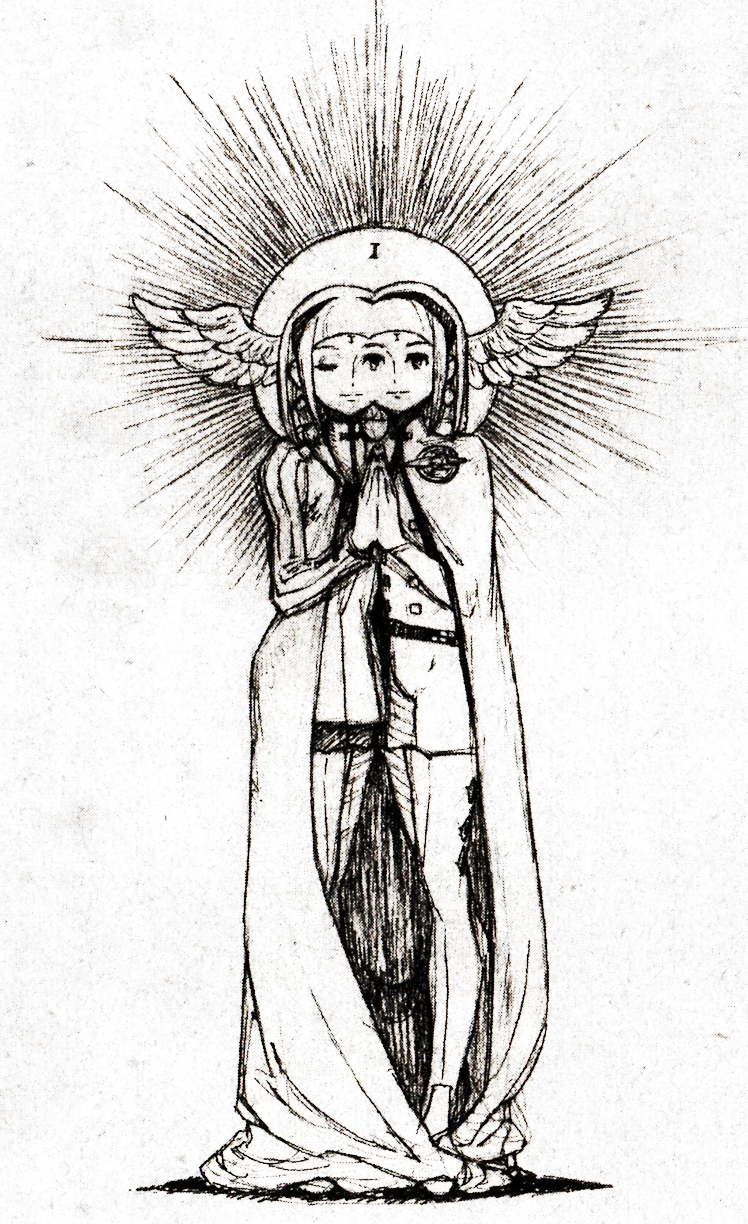
The antagonists of DoD are the Church of the Angels (天使の教会), or as the original localisation of Drag-on Dragoon would have it, Cult of the Watchers. Since we’ve already been using the word ‘Angels’, I’ll refer to it as the ‘Church of the Angels’.
The icon of the Church is a pair of faces which overlap, creating the appearance of one face with two noses and three eyes. This originates as a representation of One and her clone brother, who are separate yet overlapping people.
As for their beliefs, we learn little beyond one central mantra, rendered in the localisation as:
Speak not the Watchers,
Draw not the Watchers,
Write not the Watchers,
Sculpt not the Watchers,
Sing not the Watchers,
Call not the Watchers’ name.
‘Watchers’ in DoD1’s localisation and ‘Angels’ summoned by the Intoners in DoD3’s localisation are both translations of 天使, and refer to the same beings. What these beings are, well, we still don’t really know! (After all, no-one speaks, draws, writes, sculpts or sings of them. Tricky to research.)
Between 1004 and 1012 AD, so shortly after its founding, the Church created something known as the Seal System or World Seal (封印). The Seal is anchored in physical locations at the same Shrines occupied by the Intoner sisters, and in a person known as the Goddess of the Seal (封印の女神); should the locations be compromised, then the Goddess alone bears the ‘weight’ of the Seal.
According to the guide book, the purpose of the Seal System is to ‘anchor’ time, space and dimensions, which is vaguely encapsulated by the undefined term ‘Great Time’ (おおいなる時間).
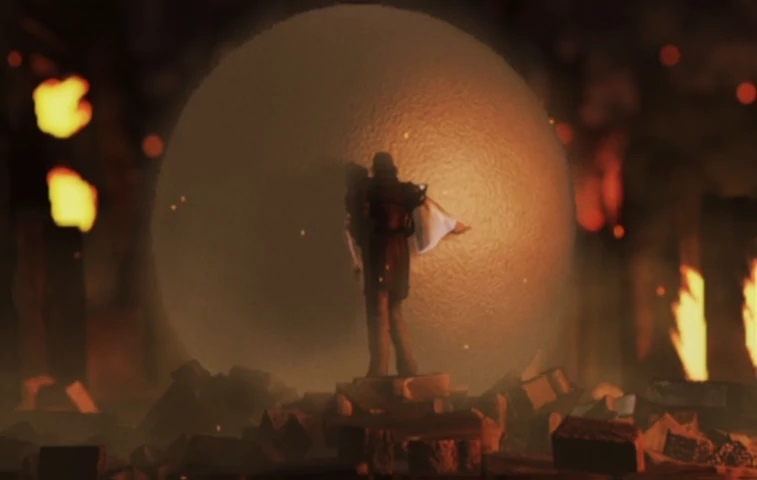
A Seed/Egg of Resurrection/Destruction, as seen in an FMV sequence in DoD.
In practice, this means the Seals prevent the manifestation of large, egg-like objects known as the Seeds of Resurrection (再生の卵, more literally ‘Eggs of Resurrection’ which is the translation I’ll use) or Seeds of Destruction. Nobody seems to know beforehand exactly what the Eggs do, but it’s undoubtedly very bad news.
However, at some point in the hundred years between DoD3 and DoD, a faction develops within the Church who take the opposite view: they want to release the Eggs in the expectation they will save the world at the point of disaster. This same faction is universally infected with ‘Red Eye’, so it may not be a sincere belief. Nevertheless, supporting this view, there’s a widespread legend that entering the Eggs of Resurrection will ‘open the path to a new and unknown humanity’ (新たな未知が拓ける).
The description of the Eggs suggests that they have existed in the world a long time, but this is hardly consistent with the rest of the timeline and may have been retconned. Regardless of their history, the Eggs are enticing to humans and magical creatures alike. In truth, the Eggs are apparently an instrument of [the] God[s] (神), intended to dispose of humanity. (nb. in the localisation, generally multiple Gods are referred to; the Japanese however is more suggestive of a single God.)
World Inside timeline: One’s brother has kids
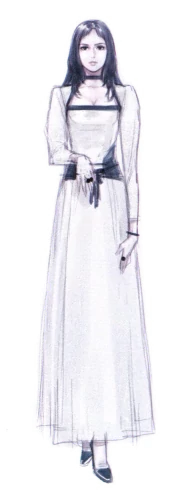
The World Inside book came packaged with the 10th Anniversary release of DoD. It contains some novellas and also some summarised backstory, including the first part of the big timeline.
The hundred-year period between DoD and DoD3 is characterised mostly by disasters. From 1012 AD onwards, the Church of the Angels appoints a succession of Goddesses of the Seal, after each one is in turn assassinated by a separatist faction (with the exceptions of the fifth [suicide] and sixth [kidnapped]). 1027-1028 AD is a particularly bad period, seeing the deaths of three Goddesses in short order. In total, 12 goddesses are mentioned, though the only one named is Asherah (pictured), who was accused of having an affair with King Gaap of Caerleon, much to God’s displeasure.
In 1021 AD, there is a civil war in the Church over the appointment of One’s brother’s aide as Goddess. The result is that One’s brother is ousted as ‘Suzerain’, which seems to be the title given to the leader. Very soon after, the Red Eye disease first appears. Its symptoms are a loss of speech control and a berserk rage, and the person becomes stronger than they would be otherwise.
(I have not been able to confirm what the corresponding Japanese term is, but the title Suzerain is used by multiple translators. It’s a bit of an odd choice of religious title—the main meaning of Suzerain is a state which exerts power over a vassal or tributary state, but can also refer to a feudal lord with vassals.)
Following his ousting, One’s brother meets a refugee called Rosa in 1024 AD, and with her has twin children called Gruen and Grenat in 1025 AD. In 1041 AD, Gruen becomes Suzerain of the Church (at which point he would be age 16). It’s not mentioned how Gruen managed to rise through the ranks so quickly, but the Church seems to have a thing for appointing One’s brother’s bloodline to positions of power!
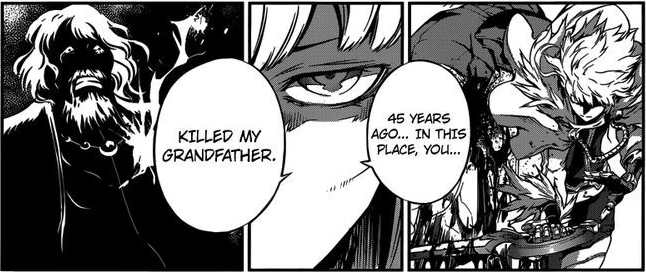
Fey discusses the death of her grandfather in Shi Ni Itaru Aka; read right to left.
In 1051 AD, One’s bro first encounters the Red Eye disease, and witnesses Gruen manipulating the infected. He kills Gruen, but spares Gruen’s son Verde, beginning a long career of murdering his descendants after they become Suzerain:
- in 1075 AD he kills Verde, but does not find the bearer of Verde’s two children, Fey and Louis.
- in 1093 AD, Louis dies to a dragon.
- in 1096 AD, he kills Fey and her daughter Chloe (as depicted in Shi Ni Itaru Aka below).
Apparently, One’s brother is unaware of the other line of descent through Grenat outside the Church, a line which eventually leads to the children Seere and Manah. Manah or the being possessing her) will herself end up in charge of the Church, but at this point, One’s brother will be in no state to intervene…
Meanwhile, a kingdom called Caerleon is founded in 1025 AD, which the wiki places ‘somewhere between Poland, Hungary and Slovakia’. There’s a succession of kings who are, by and large, assassinated. This subplot doesn’t seem to be all that important, since none of these kings get names, but eventually this will be where the main characters of DoD are born.
Novella: the The Song of a Fourteen Year-Old/The Song of Fourteen Years
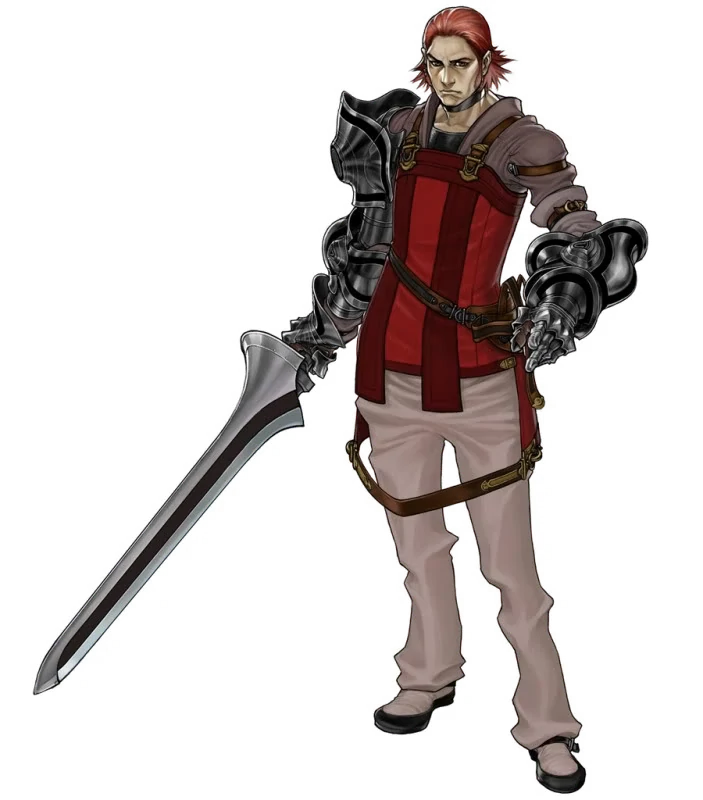
Much as with DoD3, the characters in DoD are expanded on in various novellas. These are collected in various places: the World Inside book and the Official Guide Book Complete Edition. To my knowledge, none get an official translation. Luckily, fan translators are on the job.
This novella takes place in 1093 AD, and has a translation by kho-dazat. It takes the point of view of Inuart, who is Caim’s childhood friend, four years his junior. His father, Ipris, is a vassal and close friend of Caim’s father Gaap. Inuart is besotted with Caim’s sister Furiae, and at the outset of the story, learns they’re set to be married. He’s got big old issues with masculinity, and is deeply jealous of Caim, so he drinks a ‘growth potion’ sold by a shady merchant.
Ipris intervenes, and gives Inuart some Fatherly Advice: to get girl, play harp, and stop trying to out-sword Caim. Inuart turns out to be really good at the harp (despite his lyrics being, well, what you might expect from a 14-year-old), and he shares a brief moment of sexual tension with Furiae. The story ends with him improving his swordplay and hopeful for the future.
Shi Ni Itaru Aka
The manga Shi Ni Itaru Aka is another one by Eishima Jun, featuring art by Yoo Jetae aka ZET. The title has been translated as ‘The Red Unto Death’ and ‘Fatal Crimson’. You can find information on scanlations at mangaupdates. At time of writing, scans (a mix of Kiss/Supreme Cream scans, and Rekka’s) are available here, or Rekka’s scans on archive.org here. Content warnings: explicitly portrayed rape in chapters 1 and 6 to 11, incest discussed in chapters 4 and 6 to 11, child sexual abuse attempted in chapter 13, extensive violence and gore throughout.
The manga for the most part follows One’s brother, now simply going by One, and his travelling companion, an elf named Nero who fights with crossbows. Nero is an utterly unpleasant person, concerned more or less exclusively with doing violence including rape. One’s brother is no longer the leader of the Church, but now seeks redemption, blaming it for the emergence of ‘Red Eye’ disease. ‘Red Eye’ causes its sufferers to go berserk and become much stronger, generally mostly losing control over speech and attacking whoever’s in sight.
One’s brother has a version of the ‘power of song’ used by the Intoners. Whenever he sings, however, a black dragon shows up, its intentions unclear. One is hostile to the dragon, but only Nero appears to be able to drive the dragon away with his crossbows. The black dragon is not named in the manga, but is named elsewhere as Legna.
Chapter 4-11: don’t go to Caerleon, it’s a horrible place
Shi Ni Itaru Aka takes place in three sections: a scene-setting opening in 1096 AD, a flashback set in the kingdom of Caerleon with the main characters of DoD in 1093 AD, and then a final sequence back in 1096 AD. I’m going to begin with the middle one.
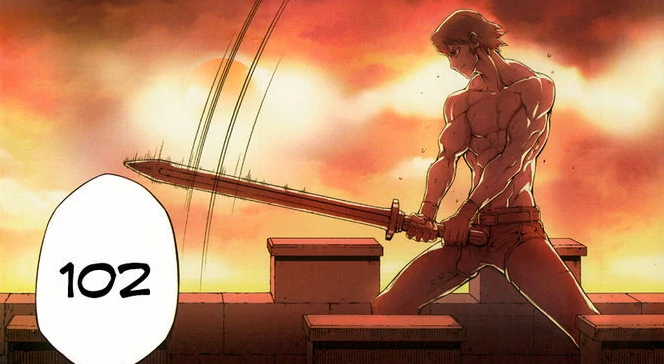
Also features: Caim doing reps.
Content warning: incest, rape
We’re introduced to a princess, Furiae, and her made, Shirley. Both of them are obsessively attracted to Furiae’s brother Caim, who is oblivious and concerned mostly with swordplay. An attack by a Red Eye sufferer is interrupted by One’s brother, but he is injured by poison and passes out.
So One’s brother and Nero spend a week in the castle. Nero attempts to rape Furiae, though One intervenes only for Furiae to hit on him instead, much to his discomfort. Nero goes outside and rapes Shirley. He locks Shirley in a barn somewhere and continues to rape her, until Shirley comes down with Red Eye and escapes, going on a rampage.
Before long, just about everyone in the castle has Red Eye. To kill the Red Eye sufferers, One’s brother uses his ‘power of song’, which causes the black dragon to arrive; as soon as it gets there, Caim’s parents make a futile attack and get torn to pieces. Though the dragon is driven off, Caim blames One’s brother for the carnage (entirely correctly, it turns out), and One’s bro and Nero make a hasty exit.
At the end, we see Accord writing in a book: Inuart should be present during these events, and his absence merits further attention. Presumably, then, something more or less similar happened in the E timeline, but with Inuart present.
Chapter 1-4: we, who are about to die, recite our backstory
Three years later, we see One’s brother and Nero attacking the Cathedral City. The church is led by One’s great-granddaugter Fey, the current Suzerain. On their way in, they briefly have to repel the black dragon Legna.
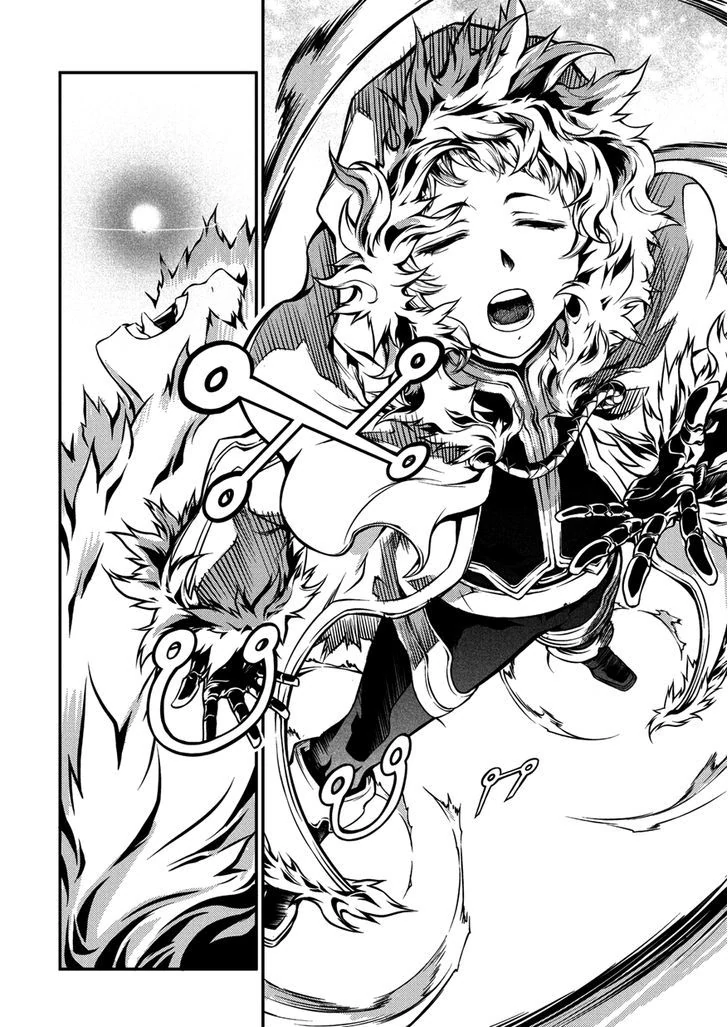
The floating letters here are in the Celestial Alphabet, which I’ll discuss in the next article!
One’s brother is here to finish off the last of his bloodline in the Church of the Angels. The two surviving members are Fey and Chloe, who make a rather desultory attempt to ambush and kill the pair using some nameless monsters. Content warning: incest, rape Fey gives a bit of her backstory, hinting that she’s been forced to bear the child of her brother Louis (or possibly Luis) before Louis died to a dragon in 1093 AD. After dealing with her various minions, One’s brother kills both her and her child, Chloe. (Similar events also take place at the same time in the E timeline.)
Chapter 12-21: tl;dr it’s One’s brother’s fault
The final section of the manga happens in another, unnamed kingdom. One’s brother and Nero witness group of Red Eye infected soldiers interrupt an execution of some ‘heretics’. Meanwhile, someone who appears just like the Intoner One attacks a castle full of the kind of decadent pedophile nobles you meet in the pages of Berserk, and does a proper February 1917 on them.
Escorted by the Red Eye soldiers, One’s brother reaches the castle, and is amazed and overwhelmed to meet his supposedly dead sister. ‘One’ claims that the Red Eyes are actually potentially peaceful, only responding with violence when threatened, and that through her, the Red Eyes are going to restore justice to the world.
But of course, this is a lie. ‘One’ turns out to be Nero’s sister, maintaining her illusion using elf-y illusion and mind control powers which seem to work even on the black dragon. When Nero breaks the illusion, they have a big old fight, which Nero’s sister wins, subduing both Nero and One’s brother fairly easily, and frees the black dragon to go ahead and finish them off. Her motivation is apparently to cause as much death and destruction as possible, a thought she enjoys so much that she starts masturbating about it in the middle of the room.
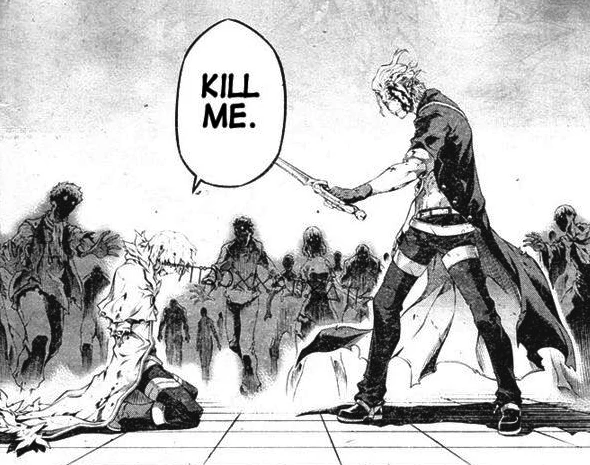
One of the few panels that isn’t too gory or nsfw to include in this article.
Legna, however, takes this opportunity to speak. It eats Nero’s sister and explains that One’s brother has, all along, been the source of the Red Eye disease. It pretty much tells One’s brother to keep up the good work, and leaves.
One’s brother, who only wanted to protect the world, begs Nero to kill him. Nero obliges in chopping his head off, but then wanders around using the (possibly still living?) head a talisman to spread Red Eye. The world descends into chaos, and Nero’s having the time of his life.
This branch continues in the DoD 1.3 novel, but we’ll address that after we’ve gone through the game.
Complete Guide entries & short stories
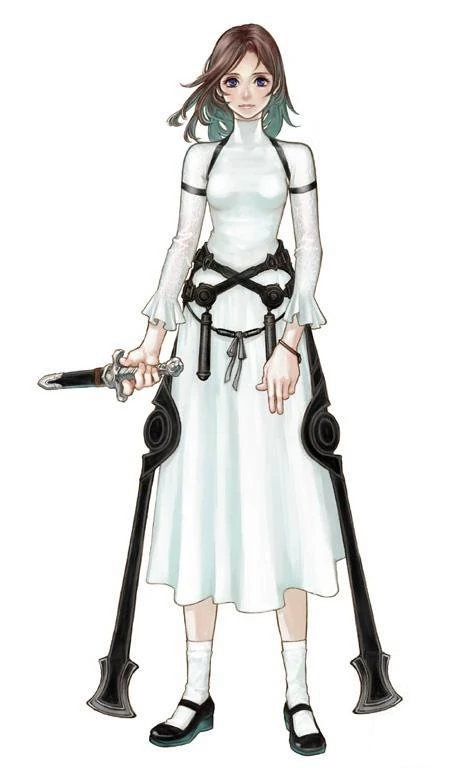
The other short stories are printed in the Official Guide Book Complete Edition, published in 2003. Since they are contemporary with the original game’s release, they might have since been retconned when DoD 3 came out. They are translated here by Dreamwidth user Kestrel alongside the original Japanese text, and reproduced on the wiki. Caim’s, Inuart’s and Furiae’s stories are just a few paragraphs long, offering only a brief snapshot of moments in the characters’ lives.
There’s some ambiguity here: at some point, the Church of the Angels splits into a Red Eye infected faction, which commands an Empire bent on destruction of everything and wishes to break the Seals, and a faction which maintains the Seal System, which is led by Hierarch Verdelet. The Complete Guide suggests a different origin to the Seal System, as a kind of inter-religious alliance, but the World Inside timeline is clear that it’s a project of One’s brother’s Church of the Angels. In any case, the Hierarch (originally 神官長, roughly senior Shinto priest) is the only one permitted to make contact with the Goddess of the Seal.
Much as in Shi Ni Itaru Aka, the black dragon attacked Caerleon’s castle in 1093 AD, and killed Caim and Furiae’s parents. In the novellas, there’s no mention of a Red Eye outbreak, or One’s brother being present, so it’s possible the black dragon showed up alone—or more likely, that when these novellas were written, that detail had not yet been devised! (The game localisation even suggests the presence of multiple black dragons, but we only ever meet one.)
After their deaths, Ipris took over as regent, but died of illness a year later. The three kids, thoroughly traumatised, become pretty much their worst selves. Caim has become cold, obsessed with nothing but revenge; Furiae all the more possessive of him, snapping at Inuart over a training accident; Inuart finds himself shut out and ever more resentful.
At some point after this, Caerleon is lost to the empire. The three kids are moved out of the country—but before long the ‘mark’ of the Goddess of the Seal appears on Furiae, painfully, indicating the death of the previous Goddess, Asherah. Furiae is thus consigned to become the Goddess of the Seal, squashing her own desires. To the Hierarch Verdelet, who manages the Seal System, Furiae comes across as a cold and distant Goddess.
The Union and the Empire
I can’t seem to find clear information about when the Church of the Angels definitively splits into a hardline cult faction, and Verdelet’s faction which manages the Goddess of the Seal. However, events seem to develop very quickly between 1096 AD (the events of Shi Ni Itaru Aka, and their parallel events in the E timeline) and 1099 AD (the events of DoD). The ‘break the Seals’ side of the Church forms an Empire, and their armies—universally infected with Red Eye—go about ransacking places, without any attempt towards diplomacy. The remaining nations, Caerleon among them, band together in a Union which opposes the Empire. Verdelet, the ‘Hierarch’ of his side of the Church, is the leader of the Union.
This state of affairs is described in the Official Guide, though the details seem a little hard to reconcile with the timeline so far and it may be outdated.
Pacts
Verdelet is a partner in a pact (関係, literally relationship or connection), in this case with a dragon. Pacts involve a human and a magical creature, and have an entry in the Complete Guide. The human gives up something—examples include their voice, hair, womb, or capacity to age beyond childhood—and the pair gain a lot of power, but if one dies, so does the other. The Complete Guide suggests that the magical creature’s side of the deal is to benefit somehow from the human’s heavy negative emotions. The formation of the pact leaves a mark on the human, termed a ‘seal’ in the localisation (紋章, literally crest or coat of arms), covering the site of the pact price.
Verdelet gave up his hair, a pretty cheap price as they go, leaving a seal on his head which resembles a tattoo. His dragon, however, has somehow subsequently become ‘petrified’. Per the wiki, Yoko Taro noted that Verdelet’s dragon is an ‘ancient dragon’, a more powerful kind of dragon which other dragons fear to oppose. How it became petrified is not attested.
Introducing your deeply, deeply fucked up party
As noted above, the theme of DoD is insanity, as Yoko Taro understood it in 2003. This is less an understanding, ‘by-and-for’ depiction of neurodivergence as much as a rather cartoonish presentation of various kinds of paraphilia and cruelty. With the exception of Seere, the main thing distinguishing your party from the Empire is that you’re not actively attempting to end the world.
Manah and Seere
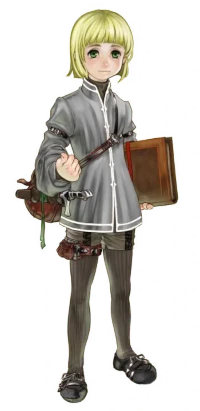
Manah and Seere’s brief lives are mostly covered in the events of DoD, but before the game starts, they are both being raised by an abusive mother. She plays favourites, doting on Seere while treating Manah like a non-person, and eventually abandoned her in a valley where she was picked up by the Church of the Angels. By the time of DoD, she’s only six years old, but some sort of other being speaks through her with a deep voice, and in her novella, we hear her preaching about the Angels.
The mother, meanwhile, is killed by soldiers of the Empire, leaving Seere alone to form a pact with a Golem at the cost of his capacity to age beyond childhood. (This Golem seems much stronger than the many destroyed by Zero over the course of DoD3, and unlike those Golems has the ability to speak.) In Seere’s novella, Golem discovers the smell of Manah.
The wiki has some comments on the writing of Seere:
Cavia developers almost consider him to be a joke character due to his persona being so starkly different from the rest of the main cast in the first game. Takuya Iwasaki feels that he is imperative for at least explaining Manah's actions and past to the players; otherwise, she would be a flat antagonist. The twins were roughly based on Natalie Portman's twelve year old character in Léon: The Professional. According to his comments in the Dengeki Online interview series, Seere's character and story for the first game was penned entirely by Yoko Taro.
Leonard
Leonard is a hermit who lives in the woods with several young brothers, characterised by overriding guilt.
Content warning: pedophilia
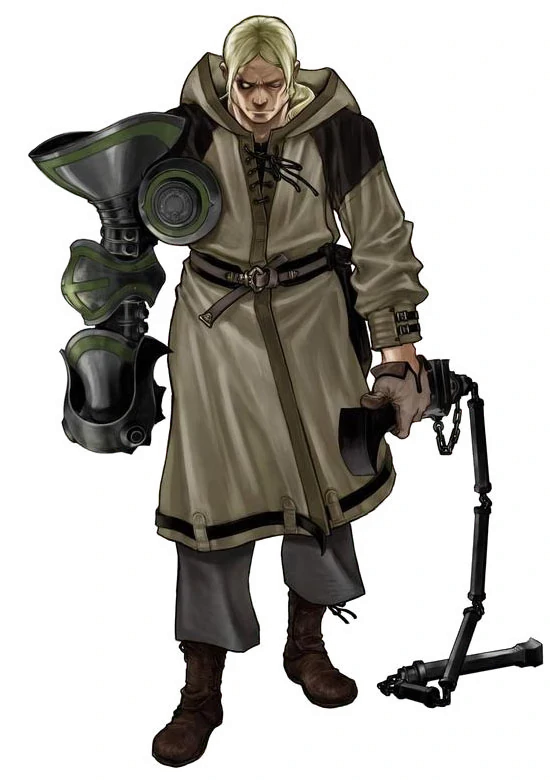
His novella, and lines of dialogue which were cut from the localisation, describe how he is secretly sexually attracted to these brothers, but deeply conflicted it. He is, thankfully, guilty enough not to act on this attraction, but instead goes into the woods to wank in secret. This is the reason that, when we first meet him in Drag-on Dragoon, he was away from his brothers when the Empire showed up and killed them all.
His guilt is compounded so much that he is easily manipulated into forming a pact by an unnamed Faerie who shows up at the site, at the cost of his sight. Like most faeries, this faerie has exactly one mode: verbally abusive on a playground level.
An unattributed paragraph on the wiki describes the writing of Leonard:
According to Yoko Taro, many scenes which explored his past and pedophilia were planned. However, they were heavily debated amongst developers for their tact and respectfulness; the scenes which remained in the game were the ones which were universally agreed upon by the team. They particularly wanted to portray him as a character who is suffering from guilt, which they think is a better fit for the game’s tone. Yoko said that Leonard was roughly based on Sleggar from Mobile Suit Gundam.
As such, the Japanese version contains relatively little discussion of his pedophilia, and all reference is cut from the localisation, which makes his introduction rather confusing. That said, I’m not sure why they thought this was a subject worth exploring in this way, and this is the element of the series that sits least well with me, but that’s what’s going on there.
Arioch
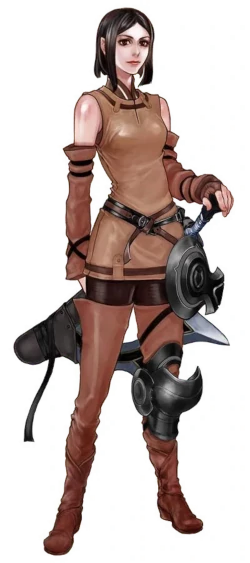
Arioch’s novella describes how she was an elf housewife, but the Empire killed her husband and son. This traumatised her so much that she started making a habit of killing and eating people, especially children. This is about the extent of her characterisation.
She is imprisoned by the Empire pending execution, but then freed by an attack by the Alliance army, whereupon she got a chance to form a pact with a pair of ‘elementals’ named Undine and Salamander (the only appearance of ‘elementals’ in any DoD game, to my knowledge). The price is her fertility, leaving a seal over her womb.
Comments on Arioch’s development are not particularly substantial:
Yoko Taro explained that her cannibalism was devised as his explanation for a mad mother wanting to “be one with children”. When asked if she wanted to devour Seere or not, he wasn’t sure. Her character was roughly inspired by Ritsuko Akagi from Neon Genesis Evangelion. According to his comments in the Dengeki Online interview series, Arioch’s character and story for the first game was penned entirely by Yoko.
The opening of Drag-on Dragoon
At the start of Drag-on Dragoon, it is 999 AD and the Empire largely seems to be winning the war. We meet Caim outside the grounds of the Castle of the Goddess, also known as the Sanctuary, under siege by the Empire. Caim kills a whole lot of Imperial soldiers, but in the process takes a mortal injury. As he fights his way into the keep, he receives word that the Empire have captured a dragon.
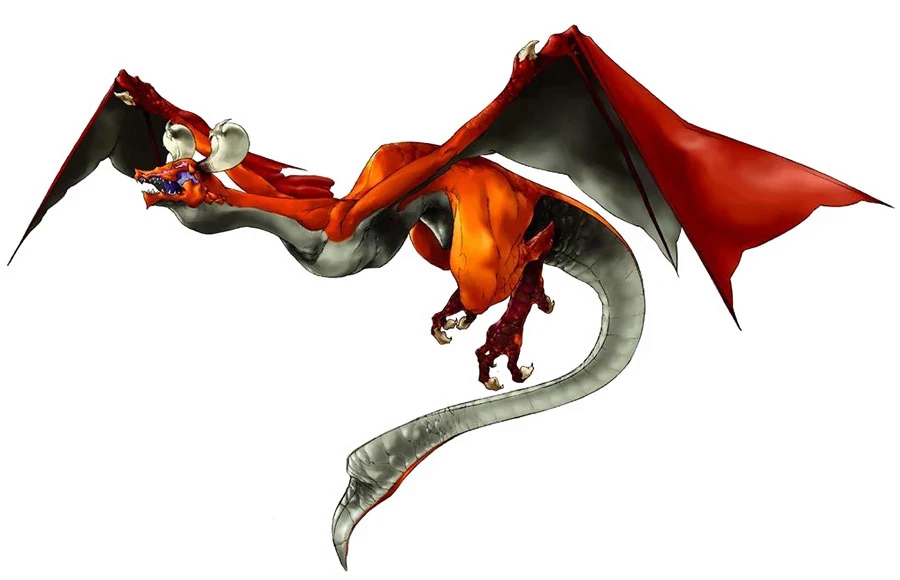
Caim finds the red dragon, who we later learn is called Angelus or Angel (rendered as a katakana transliteration アンヘル, not to be confused with the Angels worshipped by the Church, who are referred to by the kanji 天使). She is pinned down by chains in the castle courtyard, surrounded by a magic circle of unknown purpose. He raises his sword, threatening to kill her (though she is already dying), and demands to form a pact despite her evident contempt. She agrees, and the pair make, in the words of the translation, ‘the fateful decision to live’.
Caim reaches his hand into his chest, and pulls out a glowing orb with a yolk; Angelus barfs up a similar orb. The orbs unite, and the pact is sealed. The price, however, is Caim’s voice. From this point on, he can only speak through his sword.
Like DoD3, DoD has a heavily branching storyline. We’ll explore its twists and turns in the next article…
Comments